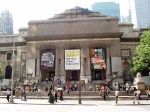 Several months ago I read a couple of tempting reviews of a new novel, The Postmistress by Sarah Blake. The story about three American women during the early years of World War II, before U.S. participation, piqued my interest. I put my name on the queue at my local library and forgot about it until it came in last week.
Several months ago I read a couple of tempting reviews of a new novel, The Postmistress by Sarah Blake. The story about three American women during the early years of World War II, before U.S. participation, piqued my interest. I put my name on the queue at my local library and forgot about it until it came in last week.
Then I read it almost non-stop for the next few days. Like the reviewers, I found it to be a well-written, well-constructed and moving story in spite of the fact that some of the contrivances and coincidences are a bit of a stretch (as in many novels, including great ones).
The title character (who says, “There’s no such thing as a postmistress. Man or woman. It’s postmaster”) and the doctor’s young wife in Franklin, Mass., a small town at the tip of Cape Cod, have their stories, but they orbit around Frankie Bard, a radio journalist with Edward R. Murrow in London during the Blitz. Her reports are broadcast to the U.S., and her stirring accounts play their part in the lives of the folks of Franklin.
Frankie grapples with the need to portray what she sees in a way that will get Americans to pay attention, yet at the same time to maintain her objectivity as a journalist. Her model and mentor is Martha Gellhorn, and a quote from The Face of War is the novel’s epigram: “War happens to people, one by one. That is really all I have to say, and it seems to me I have been saying it forever.”
In spite of my ongoing fascination with references to Virginia Woolf in contemporary fiction, I wasn’t looking for her here. Yes, Woolf and London, London and the Blitz, her horror at war itself and this war in particular, but I was still taken by surprise when she appeared, so organically woven into Frankie’s narrative. And I thought, of course!
In the section “Winter 1941,” Frankie (or the narrator) observes the dilemma: “It was nearly impossible now to look away from what was clearly happening in Europe. And the patrician habit of deflecting strong passion or insight first into calmer waters, to reflect, to take stock, belonged to her mother’s generation. Fine for Mrs. Dalloway, impossible for Mrs. Woolf. A writer, a real writer, in possession of a story headed straight for its rapids, eyes on the water, paddling fast for the middle in order to see as well, as closely as could be” (114).
In “Spring 1941,” she emerges from a shelter to a “soft blue morning” after a night of bombing. “No matter what happened, spring behaved as it always had. It was still just one morning in late May in London. On her bed under the eaves at school, these would have been the words that called to mind tea parties and strawberries and Henry James, when all civilization could be contained within the blue borders of an English sky. Except for the smoking buildings and the stink of burning rubber and metal, one might almost imagine Dorian Gray, flushed and gorgeous behind one of those windows, and Mrs. Dalloway coming out on to the square.” (160).
Clarissa Dalloway’s between-the-wars London was idyllic, her “moment of June,” a world away from the bombs and the devastation, as are, comparatively, London and New York today. The contrasts jolt readers and dramatize the fear and passion, sadness and hopelessness.
I find myself struck by the thoughtfulness of these allusions, in their relevance to both the setting and mood, in the way they illuminate perception. It strengthens my conviction that Virginia Woolf’s life and work are timeless and that writers today evoking her words and her world are doing much more than paying lip service to an icon.
Editor’s Note: For more on Woolf and contemporary fiction, read Alice Lowe’s Beyond the Icon: Virginia Woolf in Contemporary Fiction, No. 58 in Cecil Woolf Publisher‘s Bloomsbury Heritage Series.



You must be logged in to post a comment.